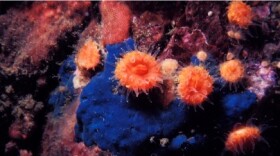A potentially record-setting season for razor clam digging in Washington has come to a screeching halt. Warm water off the coast has helped toxic algae thrive, rendering the clams unsafe to eat.
Some species of algae that razor clams feed on produce domoic acid. It’s a neurotoxin that at high levels can cause brain damage in humans and other vertebrates. Tests in mid-October showed the levels of this toxin had reached unsafe levels. The clams are unaffected, but they concentrate it in their flesh.
“So the razor clams will be fine. It's not going to bother them. They'll continue to grow,” said Dan Ayres, the coastal shellfish manager for the Washington Department of Fish and Wildlife. He expects most of the extraordinary crop of clams this year will remain for months or even years.“But for any human certainly — or marine mammal species — it's very dangerous. It actually creates permanent brain damage — not something that anybody wants to mess with.”
That’s why the health department shut down the harvest on Oct. 21.
“That was a good call. We prevented any illness. But the bad news is those levels have continued to rise,” Ayres said.
He says it was heartbreaking recently to go out sampling and find himself alone on the beach at low tide, in the midst of what truly felt like acres and acres of clams. “Literally clams just all over the place. I mean… shows everywhere. It was so easy to dig 12 clams. It was amazing.”
The source of this acid is a harmful algal bloom that’s linked to warm ocean conditions, part of what also caused the boom in razor clams. The health department will be testing Dungeness crab on the coast this week, to see if that very lucrative fishery is affected; it normally opens in December.









